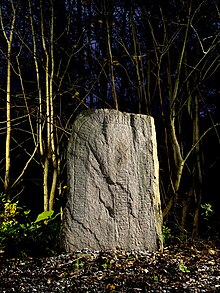Runestone from Kjellerupgård
The rune stone from Kjellerupgård (also Kjellerup Hovedgård; DR EM85; 312 or DK NJy 75 also called rune stone from Svenstrup ) stands south of Mariager in Jutland in Denmark and is (like the hobo stones I + II) a rune stone that is more typical of Sweden .
The rune stone is at the entrance to Kjellerupgård in Svenstrup, on the road from Randers to Mariager . It was found in Kjellerup Church, which stood on a hill at the junction to Svenstrup, about 200 m southwest of Kjellerupgård. There are no remains of the church or its cemetery. Such rune stones were erected in places where many people frequented. The stone was found between Randers, Hobro and Viborg in the area of Denmark in which most rune stones (approximately 30) were erected in the late Viking Age around 970-1020 AD.
The 1.57 m high, 1.0 m wide and 33 cm (bottom), 20 cm (top) thick rune stone is made of granite and its inscription, applied in two bands, reads:
- thurkutr: risthi: stin: thansi: iftir: asuith: fathur: sin: han uai: fan: arskab: mith: ilta: sunum
- Thorgot (male) or Thorgund (female) built this stone for their father Asved. He / she (endures) the grief and the "deception" with Ildes sons.
A runic inscription with a similar content is only found on Bornholm (Vester Marie 5) there is a report of a Skogi who cheated on the innocent Alfar.
The 9.0 to 12 cm high inscription begins in the lower left corner. It ends in a writing tape in the middle of the stone, which is read from bottom to top. This inscription scheme is characteristic of the rune stones, which were erected around the year 1000 and are mostly to be found on Skåne rune stones. Asved is a rare name and in Denmark only known from the rune stone DR 108, the Kolindstein .
The language is Old Danish and was written in what is known as the short or younger Scandinavian Futhark . Several characters in this 16-character alphabet have more than one meaning. It is therefore not possible to decide whether Thorgot or Thorgund had the stone erected. Due to the runes, the stone can be dated to the 10th or first half of the 11th century.
This "descent stone" is set up by family members (mother-son, son-father, etc.). There is only one other runestone that describes insidious death, while tales of sudden death are common on land or at sea, at home or abroad. These stones describe events from the upper class. The stones were erected not only in memory of the dead, but also to glorify the person who built them.
Kjellerup and Kjellerupgård
The village of Kjellerup was first mentioned in 1299 but it can be much older. King Erik Menved owned a fifth of the land at Kjellerup at that time. The place name Kongejorden (land of the king) introduced east of Kellerup probably refers to it. It is believed that the village of Kjellerup, abandoned in the 17th century, was east of Kjellerupgård. The current main building of Kjellerupgård was built in 1887–88. Before that there was a three-wing half-timbered house that was built in 1743.
The legend
Legend has it that every New Year's Eve, Kjellerupgård moves a hand's breadth closer to Kjellerup Sø (lake), which is to the north of the main building, and one day sinks into the lake.
literature
- Karen Marie Christensen: Archaeological sites and Monuments in the Mariager Area 1994 ISBN 87-90099-08-7 , p. 16
- Karsten Kjer Michaelsen: Politics bog om Danmarks oldtid . Copenhagen 2002 ISBN 87-567-6458-8 , p. 87
- Niels Åge Nielsen: Danske Runeindskrifter , København 1983, pp. 174-180
Web links
- Description Danish and pictures
- Description Danish
- Description Danish
- Description Danish and pictures
Individual evidence
Coordinates: 56 ° 35 ′ 57 ″ N , 9 ° 59 ′ 55 ″ E
